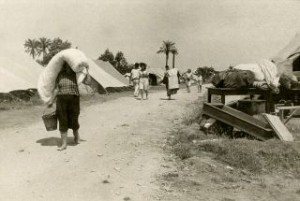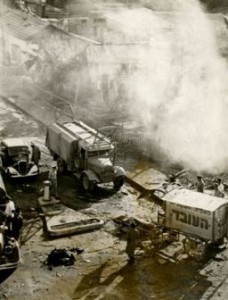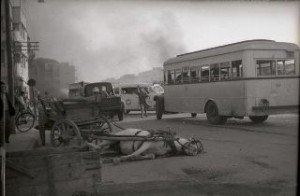The parade of events marking Tel Aviv’s centennial has been, for the most part, festive, colorful and at times sweetly nostalgic, as is appropriate for a birthday celebration. Yet Tel Aviv has known many difficult times in its 100 year history, events which have become part of the private and collective memory, leaving traces on the city and its residents. These events have played an important role in shaping the development and identity of the fun-loving, hyperactive city Tel Aviv has become today. In “White City Dark Days” an exhibit opening September 15th at the Eretz Israel Museum, curator Galia Gur Zeev presents those difficult days through documents, photographs and selections of documentary films.

The first residents of Tel Aviv experienced pain and upheaval from the beginning. In 1917, in the midst of WWI, a mere 8 days after the establishment of Tel Aviv, all residents were driven away from their homes by the Turks, who, in turn, were fleeing the British. The 1920s were permeated with undercurrents of tension and enmity between the Arab and Jewish population in Jaffa and south Tel Aviv, erupting in the violent events of 1921 and 1929. Ten years later, in 1936, the great Palestinian Arab revolt began, continuing until 1939.

In the Second World War, German and Italian planes bombed the city, killing dozens and wounding hundreds of its residents, as occurred again in 1948 when Egyptian planes bombed the city. The city was flooded several times in the 1950s, as a result of intense winter rains, particularly in the southern part of the city. Many homes were covered with mud and due to the severe damage, families were forced to evacuate.

In 1966 there was a huge fire in the Zim Building, an office building on the corner of Rothschild and Nahlat Binyamin, one of the worst fires in the history of the State of Israel. Several people were trapped on the roof, others hung from windows and gutters. One person was killed in the fire and 67 others injured.
The late 1960s ushered an era of terror attacks. One of the most significant was the 1975 infiltration of terrorists to the “Savoy” hotel on Geula Street. In the 80s there were many attacks in the area of the old central bus station. During the 90s several of these attacks targeted densely populated areas in the city such as the number 5 bus (a central route) at Dizengof Center and the Dolphinarium. The commemorative markers of these events which have become an inseparable part of the city, part of the landscape, form a central motif in this exhibit.
Curator Galia Gur Zeev says, “The documents and photos commemorate the personal tragedies, stories and confrontations of the city residents on one hand, and the memorials on the other – all these mark the fine line between private and collective memory that integrates the events, weaving them into its ethos and myths. The exhibit adds another layer to the collective memory which constitutes a defense mechanism and natural means of survival and enables us to digest these events and continue with the struggles of our daily lives.”
The exhibit offers another look at the “city that never sleeps”, whose motto during the most difficult times was “return to normal,” maintaining a vibrant cultural scene, despite all obstacles.
Top image: 1917, Tel Aviv evacuees in Rosh HaAyin
White City Dark Days opens September 15th
Eretz Israel Museum
2 Haim Levanon Street, Ramat Aviv, Tel Aviv
Information: 03-6425244/www.eretzmuseum.org.il
Hours: Sun – Wed 10:00 – 16:00, Thurs 10:00 – 20:00, Fri – Sat 10:00 – 14:00





